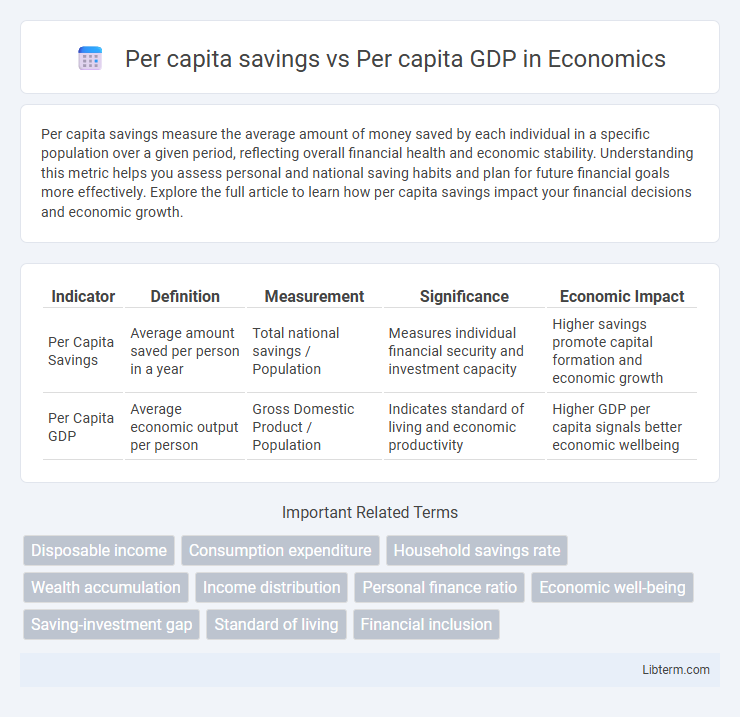Per capita savings measure the average amount of money saved by each individual in a specific population over a given period, reflecting overall financial health and economic stability. Understanding this metric helps you assess personal and national saving habits and plan for future financial goals more effectively. Explore the full article to learn how per capita savings impact your financial decisions and economic growth.
Table of Comparison
| Indicator | Definition | Measurement | Significance | Economic Impact |
|---|---|---|---|---|
| Per Capita Savings | Average amount saved per person in a year | Total national savings / Population | Measures individual financial security and investment capacity | Higher savings promote capital formation and economic growth |
| Per Capita GDP | Average economic output per person | Gross Domestic Product / Population | Indicates standard of living and economic productivity | Higher GDP per capita signals better economic wellbeing |
Introduction to Per Capita Savings and Per Capita GDP
Per capita savings represent the average amount of money that individuals in a country save within a specific period, reflecting their ability to set aside income for future use. Per capita GDP measures the average economic output per person, serving as a key indicator of the overall economic performance and living standards of a population. Analyzing the relationship between per capita savings and per capita GDP helps assess economic stability and potential for long-term growth.
Defining Per Capita Savings: Meaning and Calculation
Per capita savings measures the average amount of savings accumulated by an individual in a specific year, calculated by dividing total national savings by the population size. This metric reflects the capacity of individuals to set aside income after consumption and taxes, serving as an important indicator of economic stability and potential for investment. Unlike per capita GDP, which shows average economic output per person, per capita savings emphasizes financial prudence and future wealth accumulation within an economy.
Understanding Per Capita GDP: Concept and Importance
Per capita GDP measures the average economic output per person, providing insight into a country's overall economic health and living standards. It serves as a crucial benchmark to compare economic productivity and prosperity across different nations. Understanding per capita GDP helps to contextualize per capita savings by revealing the portion of income individuals can potentially save or invest within the economy.
Key Differences Between Per Capita Savings and Per Capita GDP
Per capita savings measure the average amount of income saved by individuals within a country, reflecting financial behavior and economic security, while per capita GDP represents the average economic output per person, indicating overall economic productivity and living standards. Key differences include that per capita savings focus on income allocation towards future consumption or investment, whereas per capita GDP centers on total production value divided by population size. Understanding both metrics provides insight into economic health, with savings influencing capital formation and GDP illustrating wealth generation.
Factors Influencing Per Capita Savings
Per capita savings are significantly influenced by income levels, with higher per capita GDP generally enabling greater savings capacity due to increased disposable income. Other critical factors include interest rates, inflation, social security systems, and cultural attitudes towards savings which impact individuals' propensity to save. Economic stability and government policies such as taxation and incentives also play pivotal roles in shaping saving behaviors at the per capita level.
Economic Indicators: Interplay between Savings and GDP
Per capita savings and per capita GDP are critical economic indicators that reveal the financial health and productive capacity of a country. Higher per capita savings often correlate with increased investment potential, fostering GDP growth through capital accumulation and enhanced productivity. The interplay between these indicators highlights the balance between consumption and investment, where optimal savings rates support sustainable economic expansion and improved living standards.
Global Comparisons: Per Capita Savings vs GDP Across Countries
Countries with higher per capita GDP often exhibit greater per capita savings, reflecting increased disposable income and financial stability. For example, nations like Switzerland and Singapore demonstrate high savings rates alongside robust GDP per capita, while lower-income countries tend to have limited savings due to constrained earnings. Variations in cultural attitudes toward saving, economic policies, and social safety nets also influence the global disparity between per capita savings and GDP.
Impact on Standard of Living and Economic Growth
Higher per capita savings rates directly contribute to increased capital accumulation, which fuels investments, enhancing productive capacity and fostering sustained economic growth. Elevated per capita GDP often reflects improved income levels, which can boost savings potential and enable higher consumption, thereby raising the overall standard of living. The interplay between per capita savings and per capita GDP creates a virtuous cycle that supports long-term economic development and improved living standards.
Policy Implications: Boosting Savings or GDP?
Per capita savings directly influence investment capacity, driving long-term economic growth, while per capita GDP reflects the overall economic output and standard of living. Policymakers aiming to boost savings should implement incentives like favorable tax treatments and financial literacy programs, which enhance domestic capital formation. Alternatively, strategies focusing on increasing per capita GDP through productivity improvements and innovation can create higher income levels, indirectly encouraging greater savings rates.
Conclusion: Balancing Per Capita Savings and GDP for Sustainable Development
Balancing per capita savings and per capita GDP is crucial for sustainable economic growth, as higher savings provide the capital needed for investment while robust GDP reflects productive output and income generation. Efficient allocation of savings into productive sectors enhances GDP growth, supporting long-term development goals and improving living standards. Policymakers should focus on strategies that encourage savings without compromising consumption, ensuring economic stability and resilience.
Per capita savings Infographic

 libterm.com
libterm.com